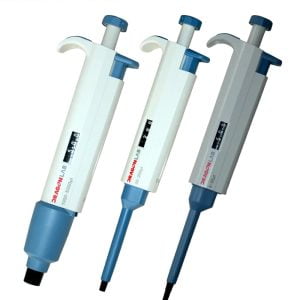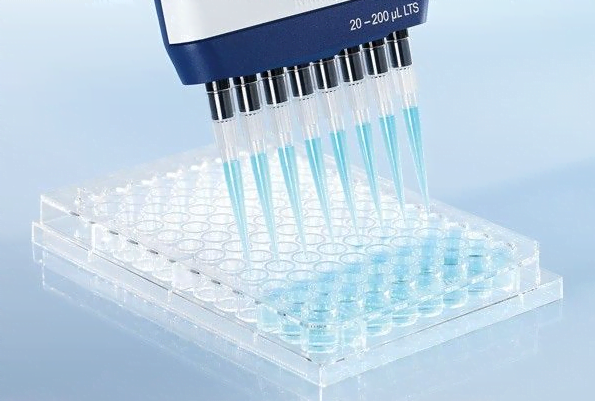A pipette is a laboratory instrument used by scientists, lab technicians, chemists, and other researchers to accurately measure and transfer small, precise volumes of liquid samples, typischerweise im Bereich von 0.1 microliters (μl) bis zu 10 milliliters (ml).
Using pipettes properly is extremely important for many experiments and laboratory protocols that require precise liquid measurements, including medical tests, chemical reactions, pharmaceutical research, PCR, and cell culture procedures. Errors in liquid measurement can significantly impact experimental outcomes and reproducibility.

What are Pipette Types based on the Working Principle?
A pipette works by aspirating or sucking liquid into a detachable tip, and then dispensing or ejecting the liquid into another container or tube. There are two main types of pipettes based on their working principle:
Air Displacement Pipettes:
The most common variety, air displacement pipettes use air to aspirate and dispense the desired liquid volume. A measured amount of air is displaced between a piston and the liquid inside the pipette tip.
Positive Displacement Pipettes:
Hier, the plunger or piston directly interacts with the liquid that fills the pipette tip during aspiration. The liquid itself moves in and out of the tip. Positive displacement pipettes are ideal for viscous liquids like oils and samples that can evaporate easily.
What Are the Different Parts of a Pipette?
While pipette designs can vary slightly between models, they typically consist of:
- A shaft that houses the piston mechanism
- A push button or electronic interface to dispense liquids
- A removable tip fitting to attach disposable pipette tips
- An ejector to discard used tips
- A display showing the aspiration volume
Pipette Tips – Why Are They Important?
Pipette tips are elongated, detachable plastic cones that fit onto the end of a pipette. They come in different materials like polypropylene and sizes optimized for different volume ranges.
Choosing tips that properly fit pipettes is necessary to ensure experimental accuracy and reproducibility. An ill-fitting tip can impact the precision of liquid aspiration and dispensing.
Importantly, using a new, sterile pipette tip for every liquid transfer helps prevent sample contamination between solutions. After use, tips are discarded to avoid carryover between samples.
What is a Calibrated Pipette?
A calibrated pipette refers to a pipette that has undergone routine testing to ensure that the volumes of liquid it dispenses match the volume settings or dial on the pipette.
This involves checking parameters like the precision/random error and accuracy/systematic error associated with volume dispensing across the operating range of a pipette.
Most pipettes allow for calibration or readjustments to improve their accuracy. Using an uncalibrated pipette can negatively impact experimental outcomes in situations like:
- Inaccurate PCR reaction set-up leading to failed experiments
- Cell culture contamination due to incorrect sterile technique
- Incorrect drug concentrations affecting cell assay results
daher, proper calibration as per the manufacturer’s guidelines helps maintain pipette health and performance.
How Often Should Pipettes Be Calibrated?
As a general rule of thumb, pipettes should be calibrated every 3-6 months to maintain optimal performance. Jedoch, the frequency depends on usage levels:
- Light-use pipettes can be calibrated yearly
- Heavy-use pipettes may need calibration every 1-3 Monate
Ideal, calibration should also be carried out:
- If dropping or damage is suspected
- After extensive pipetting of corrosive chemicals
- When wanting to use a pipette for more precision applications
- If experiment results suggest inaccurate liquid delivery
How to Calibrate a Pipette?
The standard procedure to calibrate a pipette involves gravimetric testing. This uses specialized weighing scales to compare the weight of dispensed liquid to the pipette settings. The steps include:
- Gather the pipette, compatible tips, distilled water, a thermometer, weighing dishes, an analytical balance capable of 0.1 mg precision, and other calibration accessories.
- Set up the balance in a draft-free area and adjust it to read 0 mg.
- Pre-rinse the pipette tip 2-3 times before calibration.
- Set the desired pipette aspiration volume.
- Aspirate the water sample and dispense it into the weighing tray, repeating 5-10 mal.
- Record the dispensed water weight and temperature, using the thermometer.
- Using the density of water at the recorded temperature, mathematically determine the dispensed volume.
- Compare dispensed volume to pipette setting to determine accuracy.
- Re-adjust the pipette as needed until accuracy reaches 99-101% at both the lowest and highest volumes.
Following calibration, label pipettes with calibration dates and perform routine checks between calibrations. Keep detailed logs of any calibration or maintenance issues.
Pipette Calibration Equipment
Specialized equipment like calibrated reference pipettes, analytical balances, precision thermometers, and gravimetric kits facilitate in-lab pipette calibration procedures, which help save time and cost associated with outsourcing calibration.
Investing in a certified servicing company to annually inspect and calibrate pipettes also helps meet quality compliance requirements.
What causes pipette inaccuracy?
Several common issues contribute towards pipette inaccuracy and imprecision:
- Operator pipetting technique and experience
- Ambient temperature differences
- Variations in solution viscosity and volatility
- Improper tip fitting and quality
- Overdue equipment calibration
- Wear of piston seals and improper maintenance
How can air bubbles entering pipette tips be avoided?
Air bubbles interfere with proper liquid measurement using pipettes. Strategies to avoid introducing bubbles include:
- Ensuring sufficient sample covering the tip opening while aspirating
- Releasing the pipette plunger slowly, avoiding turbulence
- Using properly fitting non-vented tips for volatile liquids
- Keeping the pipette vertical through sample aspiration and transfer
How to select the optimal pipette tips?
Choose pipette tips that:
- Provide a snug, leak-proof seal for the pipette nozzle
- Reach the necessary depth for different vessels
- Have certified quality and purity grades
- Offer the right orifice size for different sample viscosity
- Are calibrated for intended volume range transfers
- Maintain sample integrity through storage and handling
The right tips play a major role in optimizing pipetting workflows.
Abschluss
Pipettes are essential tools in science labs. Many experiments need careful liquid measuring using pipettes. Learning to use pipettes takes time, like learning a musical instrument. At first, focus on doing basic things right like checking the pipette is calibrated, using good posture and hand position, choosing the right tip type, and Learning techniques for thick liquids.
With practice, using pipettes becomes easy. You gain the skills to quickly and accurately move tiny liquid amounts without spills or errors. Expert pipetting helps scientists do great research. Medical tests, new medicines, and industrial chemistry all depend on pipettes.
